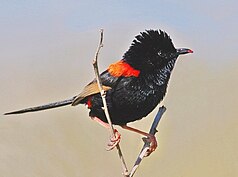Freshwater National Park
| Freshwater National Park | ||
|---|---|---|
| Red-backed easeltail ( Malurus melanocephalus ) | ||
|
|
||
| Location: | Queensland , Australia | |
| Specialty: | Hard foliage vegetation | |
| Next city: | Bumangary | |
| Surface: | 156 ha | |
| Founding: | 1973 | |
The Freshwater National Park (English: Freshwater National Park ) is a national park in the southeast of the Australian state of Queensland .
location
It is 34 kilometers north of Brisbane and 12 kilometers south of Caboolture .
The national parks Bribie Island , Pumicestone and Glass House Mountains are in the vicinity .
National nature
At 94 hectares, the park is relatively small and surrounded on all sides by populated areas and large roads. Nevertheless, there is rich vegetation and many wild animals. A small stream flows through the north.
flora
In the park, remains of the sparse hardwood forest are protected, which used to spread over the entire area. The dominant tree species are eucalyptus trees , especially the Scribbly Gum ( Eucalyptus racemosa ) with its smooth, white trunks, as well as some Angophora species . The shrub vegetation varies from open heathland with low grass trees in the south of the park to dense casuarina forests and small swampy areas with myrtle heather .
In the open heathland one finds low-growing species such as the fringed lily ( Thysanotus tuberosus ), the high sundew ( Drosera peltata ), a carnivorous plant, the flat-stemmed corduroy ( Eurychorda complanata ) and the wallum grevillea ( Grevillea leiophylla ), a sensitive, pink-blooming Grevillea, which is only 30 cm high. There are also a large number of other plants.
fauna
Especially in spring you can watch many birds in the park, especially honey-eaters . Also wrens , like the multi-color wren or the Red-backed wren ( Malurus melanocephalus ) an Australian Sängerart , occur here. Wedge-tailed eagles nest in large eucalyptus trees and often roam the park in search of food for their young. One often hears the calls of the white-throated gerygons ( Gerygone olivacea ), the gloss-tipped drongos ( Dicrurus bracteatus ) and the rainbow bee-eater .
The invertebrate fauna is also rich; there are many dragonflies - and damselfly species , especially in summer. The great dragonfly Hemianax papuensis flies through the park all year round, while in summer the Rhyothemis graphiptera with its purple-colored striped wings and the deep red Diplacodes bipunctata can be found.
Individual evidence
- ↑ Australian Government - CAPAD 2010 ( MS Excel ; 170 kB), DSEWPaC , accessed on January 7, 2013 (English)
- ↑ Australian Government - CAPAD 1997 ( MS Excel ; 93 kB), DSEWPaC , accessed on January 7, 2013 (English)
- ^ Steve Parish: Australian Touring Atlas . Steve Parish Publishing. Archerfield QLD 2007. ISBN 978-1-74193-232-4 . P. 5

